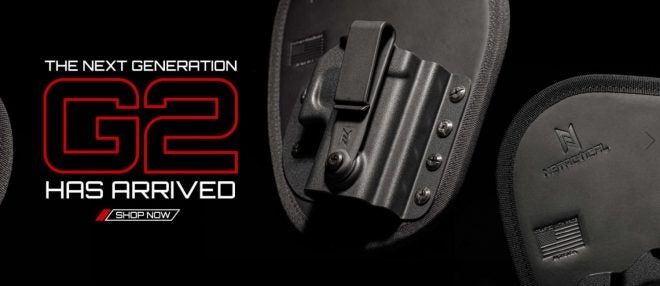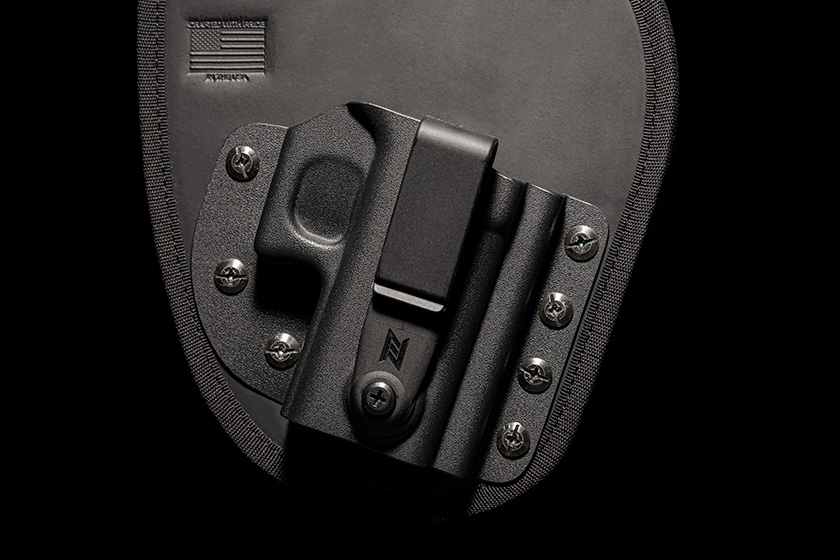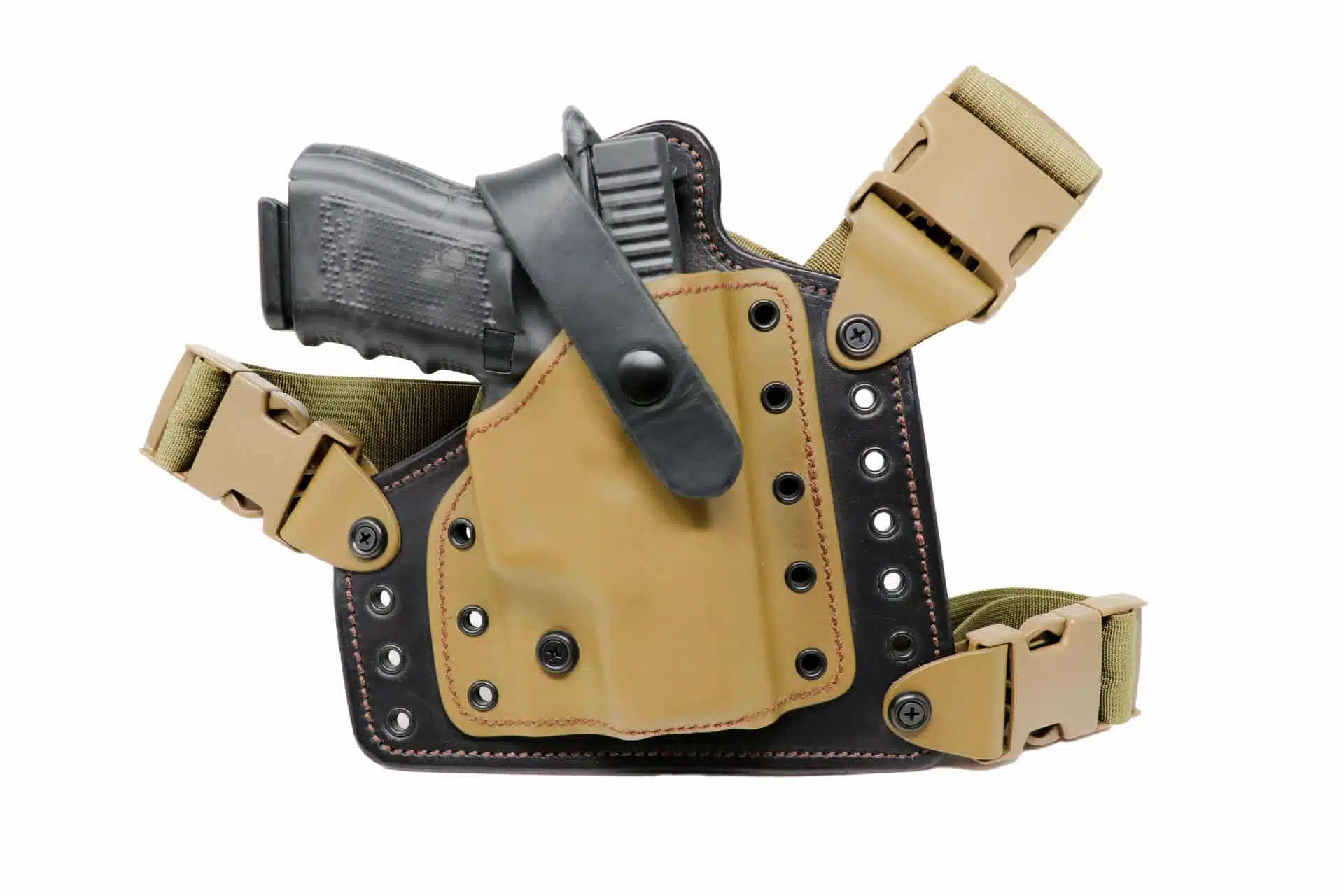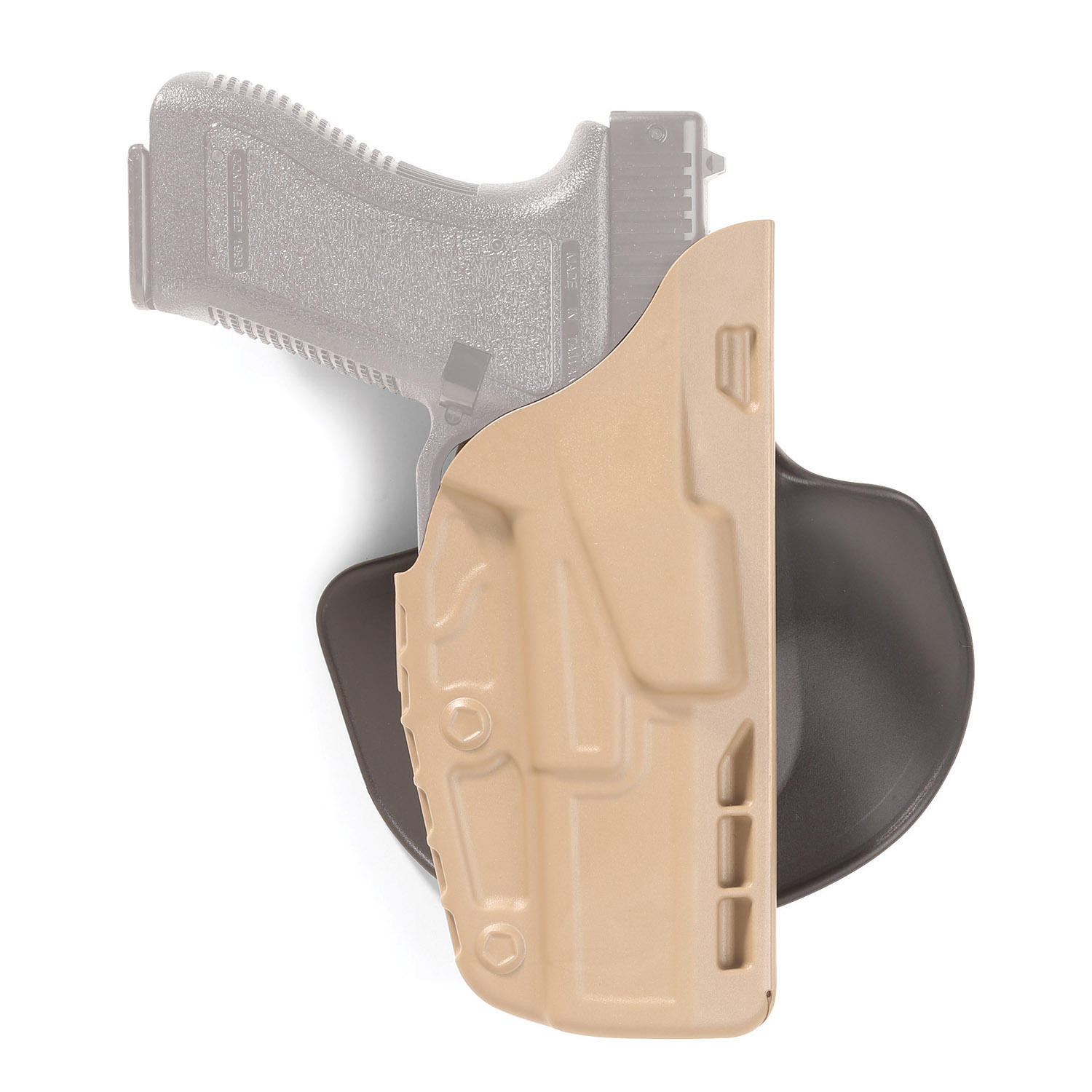Contents
- I. The Evolution of Holsters
- II. Understanding the Basics of Holsters
- III. Different Types of Holsters Available in the Market
- IV. Factors to Consider When Choosing a Holster
- V. How to Properly Wear and Adjust a Holster
- 1. Choose the Right Holster for Your Firearm
- 2. Positioning Matters: Find Your Comfort Zone
- 3. Belt Up: Use a Sturdy Gun Belt
- 4. Secure It Well: Proper Retention Is Key
- 5. Adjusting Holster Cant Angle
- 6. Check for Proper Trigger Coverage
- 7. Practice Makes Perfect: Draw and Reholster Smoothly
- 8. Regularly Inspect Your Holster for Wear and Tear
- VI. Tips and Tricks for Holster Maintenance and Care
- VII. Common Misconceptions About Holsters
- VIII. Frequently Asked Questions about Holsters
- 1. What is the purpose of a holster?
- 2. Are there different types of holsters available?
- 3. How do I choose the right holster for my firearm?
- 4. Can I use one holster for multiple firearms?
- 5. Is it legal to carry a concealed weapon with a holster?
- 6. How should I properly maintain my holster?
- 7. Can I modify or alter my holster?
- 8. Are there holsters available for left-handed individuals?
- 9. Can I use a holster while participating in various physical activities?
- 10. How should I practice drawing my firearm from a holster safely?
I. The Evolution of Holsters

Holsters have come a long way since their inception, evolving to meet the changing needs and preferences of firearm owners. From simple designs that provided basic functionality to modern innovations that prioritize comfort, accessibility, and safety, the evolution of holsters reflects advancements in technology and understanding.
A. Traditional Holster Designs
In the early days, holsters were primarily made from leather and featured a simple design: a pouch or pocket-like structure attached to a belt or waistband for carrying firearms securely. These traditional holsters offered minimal protection against elements such as moisture or dirt but served their purpose well.
As firearm technology progressed, so did holster designs. Shoulder holsters emerged as an alternative option for carrying handguns discreetly under clothing. They featured adjustable straps that allowed users to position their firearms at different angles for easy access.
B. Concealed Carry Revolution
The rise in popularity of concealed carry permits led to a significant shift in holster design philosophy during recent years. Firearm owners sought out ways to carry their weapons safely while keeping them hidden from view.
This demand gave birth to innovative concealed carry holsters designed specifically for discreet use under various clothing styles and body types. These new-age holsters are often made from lightweight materials like neoprene or Kydex, offering enhanced comfort without compromising security.
C. Technological Advances
The advent of new technologies has further propelled the evolution of holsters into the 21st century. Many manufacturers now incorporate features such as retention systems that provide an added layer of security by preventing unintentional displacement or unauthorized access to firearms.
Additionally, some modern holsters come equipped with adjustable cant angles and ride heights, allowing users to customize how their firearms are positioned for optimal comfort and quick draw. These advancements in adjustability ensure that holster designs cater to individual preferences and body shapes.
D. Holster Accessories
Alongside the evolution of holsters themselves, there has been a surge in the availability of accessories aimed at enhancing the overall user experience. These include spare magazine carriers, flashlight holders, and even integrated solutions that combine multiple tools into one convenient package.
Furthermore, manufacturers now offer holsters with versatile mounting options suitable for various carrying positions—appendix carry, strong-side hip carry, or small-of-back carry—providing gun owners with flexibility and adaptability according to their needs.
II. Understanding the Basics of Holsters

When it comes to concealed carry or open carry, a reliable holster is an essential accessory for any firearm owner. A holster not only securely holds your weapon but also provides quick and easy access when needed. In this section, we will delve into the basics of holsters, helping you understand their importance and different types available in the market.
The Purpose of a Holster
A holster serves several crucial purposes for firearm owners. Firstly, it ensures safe storage and transportation of the weapon, preventing accidental discharge or damage. Secondly, a properly designed holster keeps the gun securely attached to your body while allowing for a smooth draw when required. Lastly, a good quality holster protects your firearm from external factors such as moisture or dirt.
Types of Holsters
Holsters come in various styles and designs to cater to different carrying preferences and needs. Here are some commonly used types:
1) Inside-the-Waistband (IWB) Holster: These holsters are worn inside the waistband with part of the gun tucked into your pants for concealment.
2) Outside-the-Waistband (OWB) Holster: OWB holsters are attached outside your waistband on either side of your hip or at the back.
3) Shoulder Holster: This type of holster is worn across one shoulder with the gun resting under your opposite arm.
4) Ankle Holster: As suggested by its name, ankle holsters are strapped around your ankle beneath your pants leg for discreet carrying.
5) Pocket Holster: Designed specifically for small firearms like compact pistols, pocket holsters fit inside pockets while providing trigger protection.
6) Appendix Carry (AIWB): AIWB holsters are positioned at the front centerline region between belly button and hip bone, offering easy access.
Factors to Consider when Choosing a Holster
When selecting a holster, it is important to consider various factors that will ensure both comfort and safety. Here are a few key aspects to keep in mind:
1) Concealment: If you plan on carrying discreetly, choose a holster that offers effective concealment without printing or revealing your weapon.
2) Comfort: Look for holsters made from high-quality materials with padding or sweat shields to enhance comfort during extended wear.
3) Retention: A good holster should securely hold your firearm in place while allowing for easy draw when needed. Adjustable retention systems can offer added convenience.
4) Accessibility: Consider how quickly you can access your firearm from the chosen carry position. Practice drawing techniques with different holsters to find the most suitable option for you.
5) Durability and Quality: Invest in holsters made by reputable manufacturers using durable materials that can withstand regular use without losing functionality.
By understanding the basics of holsters and considering the factors mentioned above, you can make an informed decision when choosing the right holster for your needs. Remember, finding the perfect balance between comfort, accessibility, and safety is crucial.
III. Different Types of Holsters Available in the Market
When it comes to holsters, there is a wide variety available in the market to suit different needs and preferences. Each type offers unique features and benefits, catering to specific requirements of gun owners. In this section, we will explore some popular types of holsters that you can find in the market today.
I. Inside-the-Waistband (IWB) Holsters
IWB holsters are designed to be worn inside the waistband, providing excellent concealment for your firearm. These holsters are typically made from high-quality materials such as leather or Kydex and offer a secure fit against your body. They come with clips or loops that attach to your belt or pants, ensuring stability and minimizing printing.
II. Outside-the-Waistband (OWB) Holsters
If you prefer open-carry or have specific requirements for quick access to your firearm, OWB holsters are an ideal choice. These holsters are worn outside the waistband on your hip and provide easy accessibility without compromising on comfort. They usually come with adjustable retention mechanisms and belt loops for secure attachment.
III. Shoulder Holsters
Shoulder holsters offer an alternative way of carrying your firearm by placing it under one arm with straps crossing over your shoulders and backside comfortably securing it in place throughout the day without any strain or discomfort on either side while keeping both hands free at all times making them perfect choices when freedom matters most!
IV. Ankle Hols
IV. Factors to Consider When Choosing a Holster

Choosing the right holster for your firearm is crucial for both comfort and safety. With so many options available in the market, it can be overwhelming to make a decision. To help you navigate through this process, here are some important factors to consider when choosing a holster:
1. Firearm Compatibility
The first and most important factor to consider is whether the holster is compatible with your specific firearm model. Different holsters are designed to fit different types of firearms, so ensure that the one you choose accommodates your weapon securely.
2. Carry Style
Your preferred carry style will also influence your choice of holster. Whether you prefer appendix carry, inside-the-waistband (IWB), outside-the-waistband (OWB), shoulder holsters, or ankle holsters, there’s an option available for every preference.
3. Retention Level
The level of retention offered by a holster determines how securely it holds your firearm in place. Holsters with adjustable retention allow you to customize the tightness according to your needs and comfort level.
4. Comfort and Accessibility
A comfortable holster ensures that you can wear it for extended periods without discomfort or irritation. Look for features such as padded backings or breathable materials that enhance comfort during daily use.
5. Concealability
If concealment is a priority for you, consider choosing a holster specifically designed for concealed carry purposes. These holsters are typically slim and provide better concealment under clothing while still allowing quick access if needed.
6. Durability and Quality
A high-quality holster made from durable materials will ensure longevity and reliable performance. Look for holsters constructed from sturdy materials such as Kydex, leather, or nylon to ensure they can withstand regular use and maintain their shape over time.
7. Training and Experience
Your level of training and experience with firearms may also influence your choice of holster. Beginners may find it easier to start with simpler holsters that offer more security, while experienced users might opt for advanced features like quick-draw designs or adjustable cant angles.
8. Budget
Last but not least, consider your budget when selecting a holster. While it’s important to invest in a high-quality product that meets your needs, there are options available at different price points to suit various budgets.
By considering these factors when choosing a holster, you can find the perfect match for your firearm that ensures both comfort and safety in any situation.
V. How to Properly Wear and Adjust a Holster

When it comes to safely carrying a firearm, wearing and adjusting your holster correctly is of utmost importance. Whether you are new to holsters or have been using them for years, here are some essential tips on how to properly wear and adjust a holster:
1. Choose the Right Holster for Your Firearm
The first step in wearing a holster is selecting the right one for your firearm. Ensure that the holster fits snugly around your weapon, providing both security and accessibility.
2. Positioning Matters: Find Your Comfort Zone
Experiment with different positions until you find one that suits you best. Common options include appendix carry (in front of your body), strong-side hip carry (around 4 o’clock position), or small of back carry (around 6 o’clock position). Consider factors such as concealment, ease of draw, and personal comfort when deciding on the placement.
3. Belt Up: Use a Sturdy Gun Belt
A good-quality gun belt is crucial for proper holster support and stability. Opt for belts specifically designed to withstand the weight of firearms without sagging or shifting during movement.
4. Secure It Well: Proper Retention Is Key
To prevent accidental dislodging or unauthorized access to your weapon, ensure that your chosen holster has adequate retention features such as adjustable screws or straps.
5. Adjusting Holster Cant Angle
The cant angle refers to the tilt at which your firearm sits in the holster—often adjusted according to personal preference or drawing technique needs. Experiment with different angles until you find what works best for you in terms of both comfort and quick draw.
6. Check for Proper Trigger Coverage
It is essential to ensure that your holster fully covers the trigger guard of your firearm, providing an added layer of safety and preventing accidental discharges.
7. Practice Makes Perfect: Draw and Reholster Smoothly
Regular practice is crucial to becoming proficient in drawing and reholstering your weapon smoothly. Start by practicing with an unloaded firearm until you are confident in your abilities.
8. Regularly Inspect Your Holster for Wear and Tear
A well-maintained holster is a safe holster. Regularly inspect it for any signs of wear, such as loose screws, stretched straps, or frayed edges. Replace components as needed to maintain optimal functionality.
By following these guidelines on how to properly wear and adjust a holster, you can ensure both the safety of yourself and those around you while enjoying the benefits of carrying concealed.
VI. Tips and Tricks for Holster Maintenance and Care
Proper maintenance and care are vital to ensure the longevity and functionality of your holsters. By following these tips, you can keep your holsters in top-notch condition:
1. Regular Cleaning
Clean your holsters regularly to remove dirt, debris, and sweat that may accumulate over time. Use a soft cloth or brush to gently wipe away any residue on the surface.
2. Avoid Excessive Moisture
Avoid exposing your holsters to excessive moisture as it can lead to mold growth or damage the material. If they get wet, allow them to air dry naturally instead of using direct heat sources.
3. Store Properly
When not in use, store your holsters in a cool, dry place away from direct sunlight or extreme temperatures. Consider using a holster storage case or bag to protect them from dust and scratches.
4. Lubrication
Lubricate moving parts such as buckles or straps with a silicone-based lubricant periodically for smooth operation and prevention of rusting.
5. Check for Wear and Tear
Frequently inspect your holsters for any signs of wear and tear such as loose stitching or worn-out straps. Address these issues promptly by repairing or replacing affected parts.
6. Adjust Fitment if Necessary
If you notice that your holster is no longer securely holding its intended item (e.g., firearm), adjust the fitment accordingly by tightening screws or adjusting retention settings if available.
In conclusion,
Maintaining proper care for your holsters is essential in ensuring their longevity and optimal performance. By following these tips and tricks, you can keep your holsters in excellent condition for years to come.
VII. Common Misconceptions About Holsters
Despite their importance in firearm safety and accessibility, holsters are often misunderstood by many gun owners. Let’s debunk some of the common misconceptions surrounding holsters:
1. Holsters Are Only for Law Enforcement or Military Personnel
This is a widespread misconception that needs to be addressed. While it is true that holsters are essential for law enforcement and military personnel, they are equally important for civilian gun owners as well. Whether you carry a firearm for self-defense or recreational purposes, using a holster ensures safe storage and quick access when needed.
2. Any Holster Will Do the Job
Choosing the right holster is crucial for both comfort and functionality. Contrary to popular belief, not all holsters are created equal; each type serves different purposes depending on your specific needs and preferences. Whether you prefer inside-the-waistband (IWB), outside-the-waistband (OWB), or shoulder holsters, it’s essential to find one that securely holds your firearm while providing easy access.
3. Holsters Slow Down Your Draw Speed
This myth stems from improper holster usage or selecting an ill-fitting model without proper adjustment options. In reality, a well-designed holster should enhance your draw speed rather than hinder it. With proper training and practice, you can develop muscle memory that allows for quick and efficient draws while maintaining safety.
4. Holstering Is Unnecessary When Carrying Concealed
Avoiding re-holstering after drawing your weapon can lead to accidents due to accidental discharges or improper trigger control during this crucial moment of vulnerability. A quality holster provides a secure place to re-holster your firearm safely, reducing the risk of accidents and ensuring consistent trigger discipline.
5. One Holster Fits All Firearms
While some holsters offer versatility for multiple firearms, it’s essential to choose one specifically designed for your firearm model. An ill-fitting holster can compromise safety, accessibility, and retention of the weapon. Always check compatibility with your specific make and model before purchasing a holster.
VIII. Frequently Asked Questions about Holsters
Here are some frequently asked questions about holsters:
1. What is the purpose of a holster?
A holster is designed to securely hold and protect a firearm, allowing for safe and convenient carrying. It ensures that the gun remains in place, preventing accidental discharge and providing quick access when needed.
2. Are there different types of holsters available?
Yes, there are various types of holsters available to suit different needs and preferences. Some common types include inside-the-waistband (IWB), outside-the-waistband (OWB), shoulder holsters, ankle holsters, and pocket holsters.
3. How do I choose the right holster for my firearm?
The right holster will depend on factors such as your preferred method of carry, body type, comfort level, and firearm size. It’s important to consider these factors along with the quality of materials used and retention mechanisms offered by the holster before making a decision.
4. Can I use one holster for multiple firearms?
In some cases, you may find universal-fit holsters that can accommodate multiple firearms within a certain size range or similar models from the same manufacturer. However, it’s generally recommended to use a dedicated holster specifically designed for your particular firearm model for optimal fit and security.
5. Is it legal to carry a concealed weapon with a holster?
The legality of carrying concealed weapons varies depending on local laws and regulations in different jurisdictions or countries. It’s crucial to research and understand these laws before carrying any weapon concealed using a holster.
6. How should I properly maintain my holster?
Regular maintenance is essential to ensure the longevity and functionality of your holster. Depending on the material, you may need to clean it with mild soap and water or specific cleaning solutions. Additionally, inspecting the holster for any wear and tear and lubricating moving parts (if applicable) can help maintain its performance.
7. Can I modify or alter my holster?
Modifying or altering a holster is generally not recommended as it may compromise its safety and functionality. Holsters are designed with specific features to ensure proper retention, trigger protection, and fit for your firearm.
8. Are there holsters available for left-handed individuals?
Absolutely! Many manufacturers offer holsters specifically designed for left-handed individuals. These holsters are constructed with reversed orientation to provide easy access and comfortable carry options for those who prefer their dominant hand on the left side.
9. Can I use a holster while participating in various physical activities?
Yes, there are holsters available that cater to different physical activities such as running, hiking, or biking. These specialty holsters often feature additional support systems like adjustable straps or sweat guards to ensure secure retention during movement.
10. How should I practice drawing my firearm from a holster safely?
Safety should always be a top priority when practicing drawing your firearm from a holster. It’s recommended to seek professional training from certified instructors who can guide you through safe techniques while emphasizing proper handling, aiming, and re-holstering procedures.
Remember that these FAQs serve as general information but consulting with experts in firearms laws within your area is crucial before carrying any weapon concealed using a holster.

Brian Belko is a freelance writer and blogger. His primary areas of focus include the outdoors and shooting sports. In addition to his freelance work, Brian also writes for Wide Open Spaces and is on the Pro Staff at Military Hunting and Fishing. When he isn’t busy writing, Brian enjoys fishing farm ponds for bass and hitting the spring woods during turkey season.

